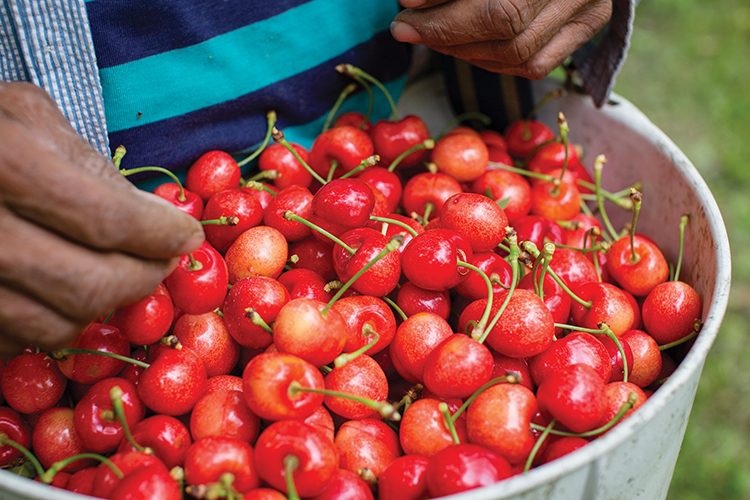
Home » Cherry picked: Growers worry about finding enough workers
Cherry picked: Growers worry about finding enough workers

June 15, 2020
Covid-19 could hurt southeast Washington’s cherry crop by limiting the number of fruit pickers allowed in orchards.
The fickle crop is healthy, delicious and highly profitable, but a litany of factors can threaten its success. If weather cooperates and diseases are kept at bay, the fruit must be picked, packed, shipped, stocked and bought before its short shelf life expires.
Covid-19 presents new challenges to the industry as it’s limiting the number of available pickers and flights, which means fewer chances to fly boxes of cherries to market. And fewer shoppers browsing produce aisles also present marketing challenges.
All things considered, Jon DeVaney of the Washington Tree Fruit Association predicts a harvest of close to 20 million boxes. That’s good considering 20 million was a dream harvest for decades.
“Early indications are down slightly from the last few years, but still good sized since we’ve been trending up,” he said.
Mother Nature always plays a role in cherry harvest success. James Smith of the National Weather Service station in Pendleton, Oregon, said summer 2020 is forecast to be hotter and drier than average, based on current trends and historical data. That’s good news for the cherry crop.
“The biggest risk with summer weather to our cherry crop is unforeseen rain followed immediately by high heat. That can lead to splitting,” said James Michael, vice president of marketing for the Northwest Cherry Growers and Washington State Fruit Commission.
Risks to cherries
It is common to see helicopters buzz the Tri-Cities after a summer rainfall to blow droplets off the fruit. Perhaps the second-biggest crisis is a spring freeze that damages new buds and blossoms. This happened a few times this year. An especially warm February woke the trees from dormancy, making them vulnerable to cold snaps over the following several weeks.
“At one point our crop looked to be heading for our earliest start to harvest on record. Then the weather cooled back down, which has adjusted our projected start back to the last few days of May,” Michael said.
Keeping the so-called “little cherry disease” from ravaging Northwest cherry orchards as it has for several years, also is critical. The name comes from the stunted, bitter fruit that results. The only solution is tearing out whole trees or entire sections, and sometimes, entire orchards.
“There may be a 2.5 million-box reduction due to frost and little cherry disease,” said DeVaney, who is president of the tree fruit association. “But that’s still within range of what we’re expecting to see for a full and normal crop.”
“Little cherry disease is more concentrated in some areas around the state, but nowhere is free from its effect,” Michael said. “Behind the scenes it’s required some aggressive intervention by our growers. There is no cure yet. … Even after removal, the ground must be attended to and the local source of infection must be addressed, otherwise growers risk re-infecting their replanted orchard.”
The culprit is likely insects, but experts haven’t yet pinpointed how they’re traveling or how to prevent them. The loss of trees might result in a 3 million-box decrease, Michael said, but the good news is the average Northwest sweet cherry has been getting bigger.
The five-year size averages have beaten the 10-year and 15-year averages. So little cherry disease is an expensive problem but it’s not interfering with hitting the 20-million-box goal, or the overall quality of the fruit.
“What we do know is that our industry’s orchard practices and packing technology ensure none of the small and bitter fruit is shipped for consumers. The high quality of Northwest cherries is a standard throughout the world, and we are committed to maintaining that bar,” Michael said.
Finding pickers
Also worrying farmers for the 2020 harvest is finding enough pickers to bring in the fruit.
“Everyone’s worried about labor shortages,” DeVaney said. “Will workers be able to travel? Will they be able to cross the border in time? Will there be restrictions as to what they can do when they get here?”
Labor shortages for the past several years have pushed farmers to request an increasing number of H-2A visa workers. Visa workers, usually from Mexico, are an expensive workforce, but they are skilled, dedicated and loyal. Local pickers are preferred, DeVaney said, but the harvest season is short, so domestic workers often migrate, following the work.
Professional cherry pickers must work quickly and not bruise the fruit or damage trees. They start in California in May and move north, arriving in Washington in June. It can be tough to hire enough for the right weeks and keep them until the job is done. Once hired, it is not uncommon for them to leave before all fruit is harvested if another orchard is paying better since they’re attempting to make the bulk of their annual income in just a few months.
“By and large agricultural employers would like to employ anyone they can, whomever is available to work and work hard,” said Pam Lewison, agriculture research director for the Washington Policy Center. “In Washington state we have a perennial labor shortage, which is where the H-2A applications always come in.”
The number of workers for each farmer who requested them is already approved, but new housing and transportation requirements could pose a challenge.
The state Department of Health announced in mid-May new emergency rules for temporary farmworker housing to increase worker safety and reduce the spread of coronavirus. The rules spell out several required steps to increase physical distancing, improve cleaning and sanitizing and outline physical distancing for all beds.
“What happens if we don’t have half our workforce? What happens to crops?” wondered Bre Elsey of the Washington State Farm Bureau.
If social distancing is relaxed, or rules softened, there’s still a question of getting a profitable price for the fruit once shipped.
Trade wars have prompted some countries to put tariffs on Washington’s sweet cherries,
DeVaney said. And because airlines are offering fewer flights, there is less opportunity to get boxes of cherries to southeast Asia and other hungry markets. So much uncertainty lies ahead, even if weather cooperates, he said.
“Cherry growers are used to making last-minute decisions and changing to circumstances,”
DeVaney said. “Luckily there is strong demand for fresh produce… and tree fruit is in a better place than some other crops because a much higher percentage goes to supermarket shelves, which are still open.”
Cherry consumers
Michael said fruit marketing experts are relying more on digital advertising, but the short cherry season means the fruit is not in anyone’s “recently bought” metrics. When people order groceries online, will they remember a bag of cherries? The produce inserts in newspapers or direct-to-consumer mailers used to be the most effective marketing tool because it alerted consumers that cherries were available, he said. The good news is grocery stores and fruit stands make high profits selling fresh, sweet cherries.
“Fortunately, retailers will be looking to promote fresh cherries to help offset the chaos they’ve been weathering. As the No. 1 dollar-per-square-foot item in July and a top-earner all summer, cherries should be able to leverage some extra attention,” Michael said.
The key to success is investing in online and in-store marketing that promotes cherries as a healthy and delicious impulse buy, he said.
Focus Magazine Agriculture + Viticulture
KEYWORDS june 2020





